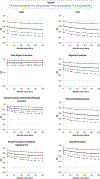Quantifying Risk Factors for Long-Term Sleep Problems After Burn Injury in Young Adults
- PMID: 27003738
- PMCID: PMC9968418
- DOI: 10.1097/BCR.0000000000000315
Quantifying Risk Factors for Long-Term Sleep Problems After Burn Injury in Young Adults
Abstract
Restorative sleep is an important component of quality of life. Disturbances in sleep after burn injury were reported but all based on uncontrolled or nonstandardized data. The occurrence and the effect of long-term sleep problems in young adult burn survivors have not been well defined. This 5-year (2003-2008) prospective multicenter longitudinal study included adults with burn injuries ages 19 to 30 years who completed the Young Adult Burn Outcome Questionnaire (YABOQ) up to 36 months after injury. The items measured 15 patient-reported outcomes including physical, psychological, and social statuses and symptoms such as itch and pain. Scores of these 15 YABOQ outcome domains were standardized to a mean of 50 and a SD of 10 based on an age-matched nonburned reference group of young adults. Sleep quality was assessed using the item 'How satisfied are you now with your sleep,' rated by a 5-point Likert scale. Patients responding with very and somewhat dissatisfied were classified as having sleep dissatisfaction and the remaining as less or not dissatisfied. The associations between sleep dissatisfaction (yes/no) and YABOQ outcome domains were analyzed longitudinally using mixed-effect generalized linear models, adjusted for %TBSA burned, age, gender, and race. Generalized estimating equations were used to take into account correlated error resulting from repeated surveys on each patient over time. One hundred and fifty-two burn survivors participated in the YABOQ survey at baseline and during the follow-up who had at least one survey with a response to the sleep item. Among them, sleep dissatisfaction was twice as prevalent (76/152, 50%) when compared with the nonburned reference group (29/112, 26%). The likelihood of a burn survivor being dissatisfied with sleep was reduced over time after the burn injury. Sleep dissatisfaction following burns was significantly associated, in a dose-dependent manner, with increasing burn size (P = .001). Better sleep was associated with better outcomes in all domains (P < .05) except Fine Motor Function, and this association was significantly more apparent in the longer term compared with the shorter term with the same domains (P < .05). Dissatisfaction with sleep is highly prevalent following burn injuries in young adults. Lower satisfaction with sleep is associated with poorer scores in nearly all quality of life measures. Satisfaction with sleep should be addressed during the long-term clinical follow-up of young adults with burn injuries. Further research should be undertaken to understand the components of sleep quality that are important to burn survivors and which ones might be modified and tested in future intervention studies.
Figures


References
-
- Vgontzas AN, Zoumakis E, Bixler EO, et al. Adverse effects of modest sleep restriction on sleepiness, performance, and inflammatory cytokines. J Clin Endocrinol Metab 2004;89:2119–26. - PubMed
-
- Heinzelmann M, Lee H, Rak H, et al. Sleep restoration is associated with reduced plasma C-reactive protein and depression symptoms in military personnel with sleep disturbance after deployment. Sleep Med 2014;15:1565–70. - PubMed
-
- Chang SP, Chen YH. Relationships between sleep quality, physical fitness and body mass index in college freshmen J Sports Med Phys Fitness. 2015;55:1234–41. - PubMed
-
- Tavernier R, Willoughby T. Bidirectional associations between sleep (quality and duration) and psychosocial functioning across the university years. Dev Psychol 2014;50:674–82. - PubMed
Publication types
MeSH terms
Grants and funding
LinkOut - more resources
Full Text Sources
Other Literature Sources
Medical
Research Materials

